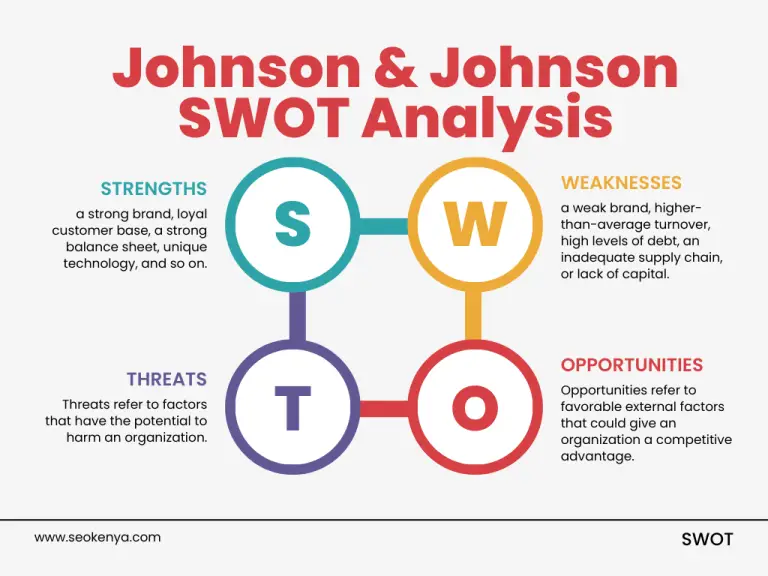In-Depth SWOT Analysis for AT&T; Strengths, Weaknesses, Opportunities, And Threats For AT&T
AT&T is one of the world’s largest telecommunications companies and one of the most recognizable brands in the industry.
With a history dating back over 140 years, AT&T has established itself as a leader in the telecommunications field, offering a wide range of services incuding voice, video, and data communication services to customers around the world.

AT&T Company Overview
Here’s a summary table with an overview of AT&T:
| Category | Details |
| Company Name | AT&T Inc. |
| Founded | 1983 (originated from the former Bell System) |
| Headquarters | Dallas, Texas, United States |
| Industry | Telecommunications, Media and Entertainment |
| Products/Services | Wireless communications, Internet, Pay TV, Home Security, Streaming Services (HBO Max, etc.) |
| Revenue | $120.7 billion (2022) |
| Net Income | $16.5 billion (2022) |
| Total Assets | $567.8 billion (2022) |
| Employees | Around 230,000 (2022) |
| CEO | John Stankey |
| Major Competitors | Verizon, T-Mobile, Comcast, Charter Communications |
In this article, we will take a deep dive into the SWOT analysis of AT&T, exploring the strengths, weaknesses, opportunities, and threats facing the company in the current market.
By conducting a thorough examination of AT&T’s current position, we can gain valuable insight into the future of the company and what it will take to stay ahead of the competition.

Strengths of AT&T
Strong brand recognition:
AT&T is a well-established brand that has a strong reputation for delivering high-quality services and products. The company has a long history of providing reliable and innovative telecommunications solutions, which has helped it to develop a strong brand image.
Diversified revenue streams:
AT&T has a diverse range of revenue streams, including mobile, broadband, and pay-TV services, as well as technology solutions. This diversification helps the company to mitigate the impact of market fluctuations and economic downturns, ensuring a stable and consistent flow of revenue.
Robust network infrastructure:
AT&T has a strong network infrastructure that is capable of providing high-speed and reliable connectivity to its customers. The company has made significant investments in its network over the years, which has enabled it to expand its services and reach new markets.
Strong financial position:
AT&T has a strong financial position, with a large customer base and a steady stream of revenue. The company has a history of generating positive cash flows, which has enabled it to make strategic investments in new technologies and services.
Weaknesses of AT&T
Heavy debt burden:
AT&T has a heavy debt burden, which has been incurred as a result of its acquisitions and investments in new technologies and services. This debt burden could limit the company’s ability to make further investments and respond to changing market conditions.
Intense competition:
AT&T operates in a highly competitive market, with a number of well-established and well-funded competitors. This intense competition could put pressure on the company’s margins and market share, and limit its ability to grow and expand its services.
Declining pay-TV subscribers:
The pay-TV market is facing a decline in subscribers, as more and more customers switch to streaming services and other alternative forms of entertainment. This could have a negative impact on AT&T’s revenue from pay-TV services.
Regulatory challenges:
AT&T operates in a heavily regulated industry, with a number of complex and changing regulations that could impact the company’s ability to grow and expand its services.
Opportunities for AT&T
Growing demand for mobile services:
The demand for mobile services is growing, driven by the increasing use of smartphones and other mobile devices. AT&T has the opportunity to capitalize on this trend by expanding its mobile services and reaching new customers.
Expansion into new markets:
AT&T has the opportunity to expand into new markets, both domestically and internationally, to grow its customer base and increase its revenue. The company could leverage its strong brand image and network infrastructure to enter new markets and compete effectively with other telecommunications providers.
Increasing demand for technology solutions:
The demand for technology solutions is growing, driven by the increasing use of technology in all aspects of life and business. AT&T has the opportunity to capitalize on this trend by offering innovative and high-quality technology solutions to its customers.
Partnership and collaboration opportunities:
AT&T has the opportunity to form partnerships and collaborate with other companies to expand its services, reach new customers, and enter new markets.
Growing demand for high-speed internet and data communication services.
With more and more people relying on these services for their personal and professional lives, AT&T has the potential to grow its customer base and increase its revenue by providing these services.
Growing demand for 5G technology.
As the world moves towards faster and more efficient communication, AT&T has the opportunity to establish itself as a leader in the 5G space, providing cutting-edge services to its customers and positioning itself for long-term success.
Expansion in the Entertainment Industry:
AT&T has the opportunity to expand its presence in the entertainment industry by acquiring new content and distribution channels.
Threats to AT&T
Economic Slowdowns:
Economic slowdowns can negatively impact AT&T’s financial performance, as customers may reduce spending on telecommunications and entertainment services.
Technological Disruptions:
Technological disruptions can lead to rapid changes in the telecommunications and entertainment industries, and AT&T may not be able to keep up with these changes.
Cybersecurity Threats:
AT&T faces cybersecurity threats, and a data breach or cyberattack could have significant financial and reputational consequences for the company.
Increased Competition:
AT&T faces increased competition from new entrants into the market, as well as from established telecommunications companies.
AT&T is a strong and well-established company with a diversified business portfolio, a strong brand reputation, and a strong network infrastructure.
However, the company also faces challenges, including high debt levels, regulatory challenges, declining revenues in traditional businesses, and intense competition.
To take advantage of the growth opportunities and mitigate the threats, AT&T must focus on expanding its presence in emerging markets, developing new technologies, forming partnerships and collaborations, and strengthening its cybersecurity measures.
Additionally, AT&T should explore ways to modernize its traditional businesses and tap into new revenue streams to stay ahead of the competition.
By implementing these strategies, AT&T can continue to grow and succeed in the highly competitive telecommunications and entertainment industries.





